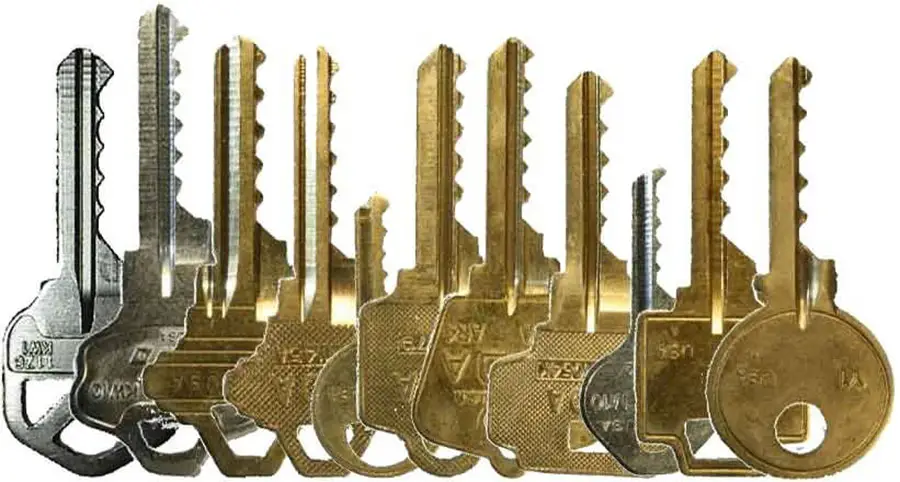
Locksmiths sometimes use bump keys to open doors when their proper keys are missing. Bump keys are simple yet effective lockpicking tools.
Using this tool can prevent breaking the lock or removing the doorknob. Its use to break into homes influences the creation of robust security lock designs. New designs may benefit your home.
Before making lock changes, understand how bump keys work.
Bump keys circumvent locks and act as a “master key” for opening most locks. All grooves on a bump key have been shaved down to the deepest possible depth making them almost universal. The name “bump” key comes from the final step in operating the key. After the key has been inserted, the back should be bumped hard enough to unlock the lock.
I personally had never heard of a bump key until recently and wanted to know more about them. Let’s explore more on what a bump key is and how it works.
How A Typical Lock Works
An ordinary lock is a combination of pins and springs attached to a turning mechanism. A key’s grooves apply a force used to raise all pins to the “shear line simultaneously,” which allows the bolt to turn over. With a bump force, a bump key can get around this.
A high-security lock adds a series of security pins and side pins. They also boast sidebars and axial rotation features. That makes a lock much harder to open without a key. A bump key won’t work on this lock. It would take some deft picking to get it open.
Unfortunately, burglars have discovered that this is a straightforward approach to do a quick break-in. It’s a simple hack for getting into various locks, which leaves almost no proof of its use. As a result, bump keys are a huge annoyance for homeowners.
Locksmiths use templates to cut the usable bump key because simple grinding tools can shape or cut these keys. Which means they are also inexpensive to make.
Locksmiths have to have a license to use these tools. Although many states file bump keys under “burglarizing tools.” you can make bump keys from spare keys and blank keys. You can also buy a premade “bump key kit” as part of training tools for locksmiths.
Bump Key Proof Your House
It might be a good idea to “bump proof” your locks. The idea is to add an extra protective layer against traceless burglaries. Advanced locks and smart locks add layers to “bump key proof” houses.
Bump-proof Basics
Changing out locks can be expensive and time-consuming. However, there are methods to secure your locks. Without investing too much, you can still improve your home protection.
Here’s how:
- Install a security system as a deterrent
- Add chain latches to your exterior entrances.
- Have a locksmith modify existing locks with more pins
- Install keyless door locks
Are Bump-proof Locks Impossible To Bump?
While bump-proofing makes it more challenging to bump a lock open, it doesn’t make it impossible.
For extra security, locksmiths recommend flip-guard deadbolt products. A flip-guard deadbolt secures the door with an extra lock that flips over the deadbolt. When people are inside the house, this guard latches. A homeowner can feel more at ease by doing this.
Flip-guard deadbolts are also pick-proof. This makes them a versatile extra security measure for various locks.
How A Flip Guard Deadbolt Works
A flip-guard deadbolt is a plate that goes over the lock on the house’s internal side of the door. It clips in place over the thumb-turn deadbolt. With this deadbolt on the back of the lock, it disables the lock’s key. Flip guards are made from metals such as brass. Install it with a screwdriver.
Where To Get A Flip Guard Deadbolt
Flip guard systems are available at most stores that sell home hardware, such as Lowes, Walmart Supercenter, and other smaller hardware chains. They range around $40-50, but prices may vary.
Check the material grade when making a flip guard deadbolt buy. Flimsy material could snap with force defeating the whole purpose of an added security layer.
Flip guard deadbolts will not work on combination code deadbolts because they cannot be installed over the code lock’s box interface.
Go For A More Advanced Lock
In some cases, you may opt to get rid of your pin and tumbler locks altogether. Instead, you can go for that “death trap” lock that is the nightmare for any novice locksmith.
A trained legal locksmith will have no problems helping you out. But, unfortunately, your friendly neighborhood criminal gets thrown off by this extra challenge.
Bump keys work on the traditional pin and tumbler lock. However, many homeowners are replacing these analog locks with bump-proof keyless mechanisms.
Products such as the Lockey M210 keyless deadbolt work for this. Other brands, such as Schlage, have faithful users who swear by their value.
Make Sure You Size Lock and Flip Guard Deadbolts To Match
Considering combining an advanced lock with a security precaution layer? Still, be sure to check product reviews. You’ll want to make sure that your flip guard will fit your advanced new lock before you fork over cash on either. It may be a good idea to invest in a lock and a guard measure simultaneously so you can match them all at once.
Replace With Combination Code Deadbolts
This key style is a push-button open deadbolt. It has a combination code and a convenient thumb-turn deadbolt for entry and exit. The code is secret, only known to those who live in the home.
Smart Locks
Homeowners add new layers of security with smart locks. Smart locks combine the advantages of IoT system management with existing locks. They also work with keyless features.
Homeowners sometimes avoid smart locks due to worries over cyber hacks adding a two-fold risk. A broken lock along with a compromised home wireless network is a two-fold headache.
The good news for concerned homeowners and WiFi users is smart lock technology is advancing all the time.
Yearly, consumers see improvements to consumer-grade smart lock systems. These add whole new dimensions to the smart lock market. Adaptations make them breach-resistant and safer to use with the home network.
Get An Expert Opinion
It’s one thing to be told smart lock tech is making strides. It’s another thing for an expert to tell you this and explain it with diluted yet fancy jargon. Lucky for you, there’s a German company that does this. AV-Test is a go-to source of smart lock test info. They run frequent scrutiny of the best smart locks that money can buy.
So, when was the last AV-Test, and what did it find? AV-Tests are ongoing. They test per-product and publish their findings in detail.
Refer To Smart Lock Tests
AV-Test did recent profiles on the Qivicon Home Base 2 system. You’ll be glad to know this system passed its certification with flying colors. That’s after AV-Test put the lock through a rigorous inspection process. The system gave it the green light for another year on the market, serving homeowners with pride.
The AV-Test is a valuable reference. It can give you a heavy technical breakdown of the smart lock or smart home systems. This is great if you want to study before you invest. Function tests cut through the marketing jargon. They give you an honest assessment of the technical value of the system.
Perks of Smart Lock Investment
Even with all that technical breakdown, are smart locks worthwhile? Are they convenient to use, and do they add extra value that a regular lock does not?
Smart locks add a lot of features that are impossible with an analog lock. For example, new smart lock systems send push notifications if you’ve left one of your doors unlocked. A solid example of things that smart locks do that standard locks cannot.
Can I Get A Pick-Proof Lock?
Unfortunately, there is no such thing (yet) as a pick-proof lock. Even smart locks have physical parts that you can circumvent. If a crafty burglar keeps any existing lock long enough or any digital security system, they can break-in. The most you can do is shield your home with extra security precautions and security systems.
Vigilance is the best defense you have in keeping your home safeguarded. Be mindful of warning signs of possible intruders. If you maintain vigilance, then you’ll know when to take heightened action.
If your locks are being tampered with, how do you know?
Smart Lock Installations Are Expensive
There is a downside to smart locks. They are expensive compared to other types of lock security. The average smart lock system is $200 or more. Compare this to the $40 flip-guard deadbolt, and you see a wide scale of expense difference.
That said, they can add extra security perks that are impossible with locks. Weigh the pros and cons. It might be worth biting the bullet to go ahead with a smart lock investment.
How To Tell If Your Locks Have Been Tampered With
Prevention is the best defense you’ll have against home intruders. You never know when they could turn up. Or do you? There are warning signs that your locks are being tampered with that you can watch for. So don’t let your resident burglar get the drop on you.
Bumping Is Only Traceless If It’s Done Right
Above, when we said that bumping is traceless? There’s a bit of a loophole to that statement. Here’s a handy secret for break-in prevention. It might even help prove a claim to the insurance policy provider. Bumping is only a traceless break-in method if it’s done right. Amateurs will leave tell-tale signs that you can pick up on.
- Fresh nicks around the keyhole
- Shiny metal edges
When you see these signs, you know that your burglar was a bit too hasty and added too much force to your lock, exposing the fact that they tampered with it.
Picking Signs
If your lock has been picked, there will be minor scratch marks. These are finer than those made by keys. The exposed, shiny metal is a flashing sign that someone in your neighborhood was up to no good.
Lock Is Not Working Right
Damaged locks are locks that have been tampered with. This comes from the blunt force robbers use. Like if they try to fly-kick their way in or with bumping and snapping techniques.
You’re going to know something is wrong with your lock when your key won’t turn quite the same. The lock might not be non-functioning. Instead, there will be a jammy feeling to the lock that something isn’t right.
How Do I Know If My Smart Lock Has Been Hacked?
Smart Locks, like analog locks, can be “picked” through cybersecurity breaches. Hacks can happen when passwords are in plain text. This means that your smart lock company doesn’t have the proper protocols in its system. Without these protocols, passwords are visible in the system. In this scenario, a hacker will have access to your passwords if they manage to hack into the company’s database. They’d sit there ready for cherry-picking.
Watch For Signs of Device Spoofing
There’s also the common issue of device-spoofing, which is identity theft of your device. Trying to get access to your device is one way of tampering with your smart lock. This is even if your system isn’t hacked directly.
Security Magazine says to watch for odd emails, text messages, phone calls, and links to suspicious-looking websites. For example, emails that appear to be from your bank warning that you have been hacked or calls supposedly from the IRS threatening you with unpaid taxes are common spoof scams.
Locks Are An Investment
Locks are among the most important investments you will ever make in your home. Advanced lock systems and security systems can make all the difference. But, when it comes to your family’s safety and well-being or a terrible event, investment is a no-brainer. This is why you take the threat of bump key use and your locks even more seriously.
How Can I Be Sure I Made A Good Investment?
Big investments can be scary ones. However, investments in something as important as home security is too big to settle for anything less than the best.
Because of the pressure on you to make the best buying decision, you want assurance you’re making the best choice. So how can you be 100 percent sure you made a good buy?
This is a simple checklist. You can tick off a few boxes before purchasing to ensure you are in a good position before you buy.
- Know your buyer goals
- Check product reviews
- Buy all available warranties
- Know the return policy on your purchase
Establish solid goals for your home security before making a purchase. Know what you want, and don’t settle for less. This is your investment, and only you can spearhead a great outcome.
Once you establish these goals, do your homework. Then, you’ll know what the other buyer’s experience was.
Get some added guarantee once you’re ready to make a decision. For example, if you purchase additional warranties, you’ll be sure to have a little insurance for the product in case it is defective or becomes damaged.
Know what the return policy is from your vendor. You may end up disliking the product for personal reasons. If you do, don’t settle for it; return it instead.






